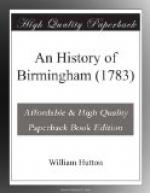But as this capacious field is beyond the line I profess, and, as I have no direct accusation against the people of my regard, I shall not enter.
DERITEND BRIDGE.
Cooper’s-mill, situated upon the verge of the parishes of Afton and Birmingham, 400 yards below this bridge, was probably first erected in the the peaceable ages of Saxon influence, and continued a part of the manorial estate ’till the disposal of it in 1730.
Before the water was pounded up to supply the mill, it must have been so shallow, as to admit a passage between Digbeth and Deritend, over a few stepping stones; and a gate seems to have been placed upon the verge of the river, to prevent encroachments of the cattle.
This accounts for the original name, which Dugdale tells us was Derry-yate-end: derry, low; yate, gate; end, extremity of the parish; with which it perfectly agrees.
The mill afterwards causing the water to be dammed up, gave rise to a succession of paltry bridges, chiefly of timber, to preserve a communication between the two streets.
But in later ages, the passage was dignified with those of stone. In 1750, a wretched one was taken down, and the present bridge erected by Henry Bradford and John Collins, overseers of the highway, consisting of five arches; but the homely style, the deep ascent, and the circumscribed width prevents encomium.
ADJACENT REMARKS.
SOHO.
If we travel two miles from the centre of Birmingham, upon the Wolverhampton road, which may be called, the road to taste, and is daily travelled by the nobility and gentry, we shall arrive at the epitome of the arts.
Though this little spot lies in the county of Stafford, we must accept it as part of Birmingham; neither is it many yards distant from the parish.
The proprietor, invited by a genius, a fortune of 30,000_l_. and a little stream, which promised to facilitate business, has erected the most elegant works in these parts, said to accommodate seven hundred persons. Upon that hungry ground, where, in 1758 stood one paltry cottage, we now behold, a city in miniature.
From this nursery of ingenuity, originated the Soho button, the single wheel clock, the improvement of the steam engine, the platina button, the method of taking exact copies of painting, writing, &c. also, the productions of fancy, in great variety; with which some of the European princes are well acquainted.
To the genius of the place is owing the assay-office, for marking standard wrought plate, which, prior to the year 1773, was conveyed to London to receive the sanction of that office; but by an act then obtained, the business is done here by an assay master, superintended by four wardens: these are annually chosen out of thirty-six guardians, whose chief duty consists in dining together, at least once a year; for it appears from the chapter upon government, that feasting makes a principal part of a Birmingham office; and, however unwilling a man may seem to enter in we generally find him pleased when he is in.




